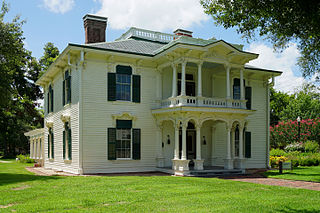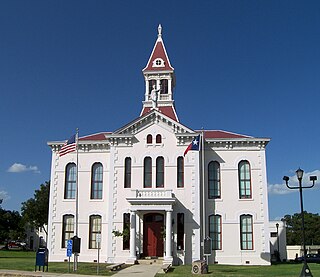
The Sam Bell Maxey House is a historic house in Paris, Lamar County, Texas. Samuel Bell Maxey, a prominent local attorney and later two-term U.S. senator, built the large two-story house after serving as a major general in the Confederate Army. It is built in the High Victorian Italianate style.

Fort McKavett State Historic Site is located in Menard County, Texas, United States. Fort McKavett was a frontier fort established as Camp on the San Saba in 1852 to protect settlers from Indian raids. The camp was renamed in honor of Captain Henry McKavett, who was killed in the Mexican–American War battle of Monterrey.

Liendo Plantation is an historic cotton plantation in Waller County, Texas, United States. Named after its original owner, José Justo Liendo, the plantation was purchased in 1873 by sculptor Elisabet Ney and her husband, physician Edmund Montgomery. The plantation is a Recorded Texas Historic Landmark and is listed on the National Register of Historic Places.

The Kendall Inn is a historic hotel located in Boerne, Texas, United States, that originally opened in 1859. The building was added to the National Register of Historic Places on June 29, 1976.

Cherry Spring is an unincorporated farming and ranching community established in 1852 in Gillespie County, in the U.S. state of Texas. It is located on Cherry Spring Creek, which runs from north of Fredericksburg to Llano. The creek was also sometimes known as Cherry Springs Creek by residents. The community is located on the old Pinta Trail. The Cherry Spring School was added to the National Register of Historic Places Listings in Gillespie County, Texas on May 6, 2005. The school was designated a Recorded Texas Historic Landmark in 1985.

The Bandera County Courthouse and Jail are two separate historic county governmental buildings located near each other in Bandera, Bandera County, Texas, The Bandera County Courthouse, built in 1890 at the corner of Main and Pecan streets, is a Renaissance Revival style building designed by San Antonio architect B.F. Trester. It is three-story building with a central clock tower made from rusticated limestone cut from a local quarry. The current jail is a non-historic, modern facility located along State Highway 16 on the north end of town.

The architectural structures of Fredericksburg, Texas are often unique to the Texas Hill Country, and are historical edifices of the German immigrants who settled the area in the 19th Century. Many of the structures have historic designations on a state or national level. The Gillespie County Historical Society is actively involved in assisting with preservation. On October 14, 1970, the Fredericksburg Historic District was added to the National Register of Historic Places in Texas.

Lower South Grape Creek School is located at 10273 E U.S. Highway 290 in Gillespie County, Texas. In 1960, the school was consolidated with Fredericksburg Independent School District. The building is now used as a community center. The school was designated a Recorded Texas Historic Landmark in 1994, Marker number 10073. It was added to the National Register of Historic Places in Texas on May 6, 2005.

Luckenbach School is a Recorded Texas Historic Landmark and on the National Register of Historic Places Listing. It is located at 3566 Luckenbach Rd. in Gillespie County, Texas. In 1964, the school was consolidated with Fredericksburg Independent School District. The building is now used as a community center.

The Llano County Courthouse and Jail were erected separately, but added to the National Register of Historic Places in Texas on December 2, 1977 as one entry. The courthouse, located in the middle of Llano's historic square, was built in 1893. The exterior is made of sandstone, marble, and granite. The interior of the courthouse was damaged by fire in 1932 and again in 1951. It is still in use today by local government. The jail was erected in 1895, with the prisoner cells on the second and third floors, and the ground level solely for the office and living accommodations for the sheriff and his family. The jail was designated a Recorded Texas Historic Landmark 1979, Marker 9448. The courthouse was designated a Recorded Texas Historic Landmark 1980, Marker number 9446.

DeLeon Plaza and Bandstand is 1.77 acres originally platted as the center of the city of Victoria, county of Victoria, in the U.S. state of Texas. The bandstand stood nearby the plaza until it was moved to the center of the plaza in 1923. The William P. Rogers chapter of the United Daughters of the Confederacy contracted with sculptor Pompeo Coppini for the DeLeon Plaza's 1912 monument to the Confederacy The Last Stand.

The Wilson County Courthouse and Jail are located in Floresville, Texas. They were added to the National Register of Historic Places in Texas in 1978 and the courthouse as a Recorded Texas Historic Landmark in 1984.

The Fredericksburg Memorial Library, also known as the Pioneer Memorial Library or the Old Courthouse, is located at 115 W. Main Street, Fredericksburg, Gillespie County, in the U.S. state of Texas. Designed by Alfred Giles, it was built in 1882 to replace the original 1855 courthouse, and was later superseded by the current 1939 courthouse designed by Edward Stein. The first floor houses the Pioneer Memorial Library, while the second floor functions as community hall. It is often called the McDermott Building because of the 1967 and 1984 restorations funded by Mr. & Mrs. Eugene McDermott. It was added to the National Register of Historic Places in 1971, and was designated a Recorded Texas Historic Landmark in 1967.

Alfred Giles (1853–1920) was a British architect who emigrated to the United States in 1873 at the age of 20. Many of the private homes and public buildings designed by Giles are on the National Register of Historic Places and have been designated Recorded Texas Historic Landmarks. Based in San Antonio, his buildings can be found predominantly in south Texas and northern Mexico. Giles is credited with "a profound influence on architecture in San Antonio."

The Badu Building is located in the city of Llano, county of Llano, in the U.S. state of Texas. It was added to the National Register of Historic Places listings in Llano County, Texas in 1980, and designated a Recorded Texas Historic Landmark in 1981. It has also been known as the Badu House and as the Carol Phelan Building. It is now being operated as a restaurant and private event space under the name of Badu 1891.

The Roper Hotel is located at 707 Third Street in the city of Marble Falls, county of Burnet, in the U.S. state of Texas. It was erected circa 1888. The hotel was designated a Recorded Texas Historic Landmark in 1981, and added to the National Register of Historic Places listings in Burnet County, Texas on January 8, 1980. The two-story structure was originally built by George and Elizabeth Roper. The building changed hands and names in 1926 and 1963, and is currently occupied by a medical clinic.

Acequia Madre de Valero is an 18th-century agricultural irrigation canal built by the Spanish and located in the Bexar County city of San Antonio in the U.S. state of Texas. When Martín de Alarcón founded San Antonio for Spain by establishing San Antonio de Valero Mission in 1718, Franciscan priest Antonio de Olivares and the Payaya Indians dug Acequia Madre de Valero by hand. It was vital to the missions to be able to divert and control water from the San Antonio River, in order to grow crops and to supply water to the people in the area. This particular acequia was the beginning of a much wider acequia system. Acequia Madre de Valero ran from the area currently known as Brackenridge Park and southward to what is now Hemisfair Plaza and South Alamo Street. Part of it that is not viewable by the public runs beneath the Menger Hotel. The acequia was restored in 1968 and that year was designated a Recorded Texas Historic Landmark.

The Wood–Hughes House is a historical house located at 614 S. Austin in Brenham, Texas. Built in 1897, the house is an example of Late Victorian architecture. Owners W. A. and Fannie Wood built the house using high-quality lumber and siding that resembled stone. The house was purchased by planter and rancher Henry W. Hughes in 1913. The house resembles the F. W. Schuerenberg House, which is also in Brenham.

The Hudspeth County Courthouse is located in the town of Sierra Blanca, the seat of Hudspeth County in the U.S. state of Texas. The courthouse was constructed in 1919 and added to the National Register of Historic Places in 1975. The Texas Historical Commission (THC) has also designated the building as a Recorded Texas Historic Landmark since 1962 and as a State Antiquities Landmark since 1981. The county is named for Claude Benton Hudspeth who served as a U.S. Representative from El Paso and previously in both houses of the Texas Legislature where, as a member of the Texas Senate, he was influential in the county's creation.



























